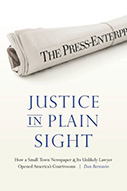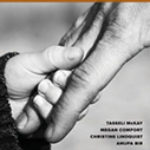Justice In Plain Sight: How A Small-Town Newspaper And Its Unlikely Lawyer Opened America’s Courtrooms

Author: Dan Bernstein
Publisher: Lincoln, NE: University of Nebraska Press, 2019. 280p.
Reviewer: Clay Calvert | September 2020
In April 2019, a trial court judge in New York denied both the press and the public access to a pretrial hearing in a sexual assault and rape case against disgraced movie mogul Harvey Weinstein. The judge cited concerns about Weinstein’s Sixth Amendment right to a fair trial being prejudiced. The hearing in question dealt with whether prior allegations of sexual misconduct against Weinstein involving other women (women not involved in the case before the court) would be allowed into evidence. Multiple media organizations objected to the closure, citing an unenumerated First Amendment right of the press and public to attend criminal proceedings. But Judge James Burke rejected their motion. He concluded that banning press and public access to the courtroom for the hearing was “the only means available to avoid the tainting of the jury pool.”
Did the judge get it wrong? To provide some critical context for answering that question, it helps to read journalist Dan Bernstein’s well-written and meticulously researched new book, Justice in Plain Sight. It tells the backstory of the individuals and the newspaper behind two United States Supreme Court decisions from the 1980s – Press-Enterprise v. Superior Court, 464 U.S. 501 (1984) and Press-Enterprise Co. v. Superior Court, 478 U.S. 1 (1986) – that established a presumptive (albeit not absolute) First Amendment right of press and public access in criminal cases to attend the voir dire proceedings in which jurors are selected (Press-Enterprise I) and the preliminary hearings that necessarily come before any trial possibly occurs (Press-Enterprise II).
Attorneys who practice in the First Amendment press-freedom space collectively refer to the cases as establishing the Press-Enterprise test. That test initially determines whether there is a presumptive right of access to attend a specific aspect or phase of a criminal proceeding. If such a right is found to exist under Press-Enterprise’s history-and-logic consideration (discussed more later in this review), then the test provides the hurdles that must be cleared before the proceeding or a document related to it may permissibly be closed or sealed.
This is much more than just a feel-good story (although the book sometimes embraces that narrative) about a relatively small-city newspaper and its people – the editors and the attorneys, each of whom Bernstein fleshes out as an integral character in this drama – fighting the good fight (two fights, actually) and winning important cases more than 2,200 miles away from home before the nation’s highest court.
Among other things, the book makes it clear that the Supreme Court almost declined to hear both Press-Enterprise I and Press-Enterprise II. Bernstein takes readers inside the justices’ chambers as the newspaper sought to obtain the four votes necessary for the Court to agree to hear each case. He pulls this off deftly by using the public papers of several justices and the memos of their clerks at the time, at least one of whom (Alan Madans, who clerked for that late Justice Harry Blackmun) Bernstein interviewed.
We learn that in Press-Enterprise I, only two members of the Court – Justices Thurgood Marshall and William Brennan, staunch liberal stalwarts by today’s standards – voted to hear the case during the Court’s initial vote on January 14, 1983. That left the case two votes short of the necessary four to take it up. At a second vote one week later, Justice Sandra Day O’Connor – the first woman on the Supreme Court and the individual who would become the Court’s pivotal swing vote or median justice before she retired – added her vote to hear the case.
At that stage, the newspaper still needed one more vote to reach the big time. It ultimately came from Justice Harry Blackmun. He had jotted “Join 3” in his papers on the initial vote, indicating he would add the fourth and decisive vote if three other justices committed to hearing the case. So, when O’Connor added her vote, Blackmun did the same. In brief, it was not easy to get to the four votes that ultimately led to the nine-to-zero decision in favor of the Riverside newspaper in Press-Enterprise I. It was a decision that broke First Amendment ground for all newspapers, big and small, and all members of the public, rich and poor, to attend voir dire in criminal cases.
Almost the same scenario played out on the certiorari vote in Press-Enterprise II. Only Marshall, Brennan and Byron White voted to grant the petition when the justices cast their first ballots. Justice Blackmun again stepped in to provide the pivotal fourth vote, as he had written – just as he had done in Press-Enterprise I – “Join 3” during the initial vote.
The book generally moves chronologically and at a good clip. And when Bernstein decides to take a brief detour into some major access and press cases that came before Press-Enterprise I, he does so knowingly and with a subtle sense of humor, referring to it as an “eat-your-spinach primer.” Indeed, you don’t need to be a First Amendment expert – the Press-Enterprise’s hometown attorney, Jim Ward, who successfully argued both cases before the Court, was not one – to enjoy and understand this book. That’s full credit to Bernstein and his journalistic writing talents; this is anything but a dull and dry history.
Attorney Ward’s lack of experience on First Amendment cases actually provides a bit of intrigue in Justice in Plain Sight. Bernstein explains that once the Court agreed to hear Press-Enterprise I, Tim Hays, the newspaper’s editor and son of the owner, was lobbied by publishers from the East Coast to replace Ward, who specialized in business law, with a First Amendment specialist. As Bruce Sanford, the Baker & Hostetler attorney who played a leading role in authoring critical friend-of-the-court briefs filed in support of the newspaper in both cases, colorfully tells Bernstein and his readers, it was “not too surprising that when a case was granted cert that the New York people would swoop in and try to get the case. . . . It’s the New York view of the world: Nobody is as smart and great as we are.”
Perhaps it was also a good thing that the two cases were not fought by more prominent, East Coast-based newspapers. As Sanford puts it, “[t]his Court wasn’t wild about the New York Times and Washington Post. They liked that it wasn’t the same old players bringing the case. Here you had a medium-sized paper saying it’s very important in our community to cover criminal trials. It was so much more appealing than the big newspapers swaggering in.” Kudos here to Bernstein for doing his due diligence in interviewing an attorney who helped to write friend-of-the-court briefs that abetted the transformation of First Amendment law.
Bernstein also packs his tome with interesting and memorable factoids. For example, one learns that the bench behind which the Supreme Court justices now sit was fashioned into a curve shape – rather than a straight line – at the request (perhaps order?) of Chief Justice Warren Burger “so the justices could see other.”
Another interesting tidbit is that Justice Blackmun, in his notes during oral argument, graded the attorneys arguing before him. Jim Ward received a “5” (on a scale from 1 to 10) from Blackmun in both cases, with Blackmun adding “whine” next to Ward’s name in the second. Although middling, that was a better score than Blackmun gave to Joyce Reikes, Ward’s opposing counsel in Press-Enterprise II. Blackmun bestowed her a “4” and wrote “medium blond, plump” in his notes.
Bernstein also peppers his book with the roles played in Press-Enterprise I and Press-Enterprise II by some seemingly unlikely, yet famous, people. To wit, both John Hinckley, who shot President Ronald Reagan, and Aaron Burr, who shot and killed Alexander Hamilton, play important parts in the lawsuits. Hinckley’s voir dire was closed. The jurors’ later determination that he was not guilty by reason of insanity was questioned when it was discovered “that relatives of several jurors were once confined to mental hospitals.” In brief, his voir dire should have been open to create a perception of integrity of the trial. As for Burr, it turns out that his preliminary hearing was open to the public, suggesting a long history of such proceedings being open, even in high-profile cases.
The book also illustrates the power of friend-of-the-court briefs. In the merits friend-of-the-court brief filed on behalf of several major national newspapers and news organizations, one gets to see the origin of the history-and-logic prong of the Press-Enterprise test come to life. Attorney Lee Levine (then “not yet thirty” and working at Baker & Hostetler with Bruce Sanford) helped to draft that brief. In interviews with Bernstein, Levine said he saw the Court as having two factions, both of which the newspaper needed to win in order to get to five votes and prevail. First, there was the “Burger Faction” (after Chief Justice Warren Burger) that “believed the First Amendment was a function of history. A First Amendment right had to show this history of openness.” Then there was the “Brennan Faction” (after Justice William Brennan). It was more concerned with the purpose, function and logic behind having a proceeding be open. The fact noted above that Aaron Burr had an open preliminary hearing was used adroitly in PressEnterprise II to help win the vote of Burger who, we discover, “knew the Burr trial inside and out.”
A sage piece of advice about friend-of-the-court briefs that comes through in Bernstein’s description of Press-Enterprise I is this: Have one brief filed on behalf of national news entities and organizations, and have another brief filed by entities and organizations from the home state of the newspaper fighting the case. And, of course, the content of those two briefs should not be duplicative.
Readers also receive lessons about how a case is strategically framed by the opposing parties. In Press-Enterprise I involving access to voir dire proceedings, Ward argued before the justices that it was a closure case. The opposition framed it as a dispute about juror privacy. Bernstein’s inclusion of verbatim snippets of the transcripts of the oral arguments in both cases works exceedingly well to illustrate such matters.
In summary, it is one thing for an attorney litigating an access case today to know and memorize the Press-Enterprise test. But as Bernstein’s book reveals, it is a far more interesting thing to understand the backstory about how that rule evolved and to appreciate the hard-fought efforts of so many people that went into it.
Clay Calvert, Professor and Brechner Eminent Scholar in Mass Communication and Director of the Marion B. Brechner First Amendment Project, University of Florida


